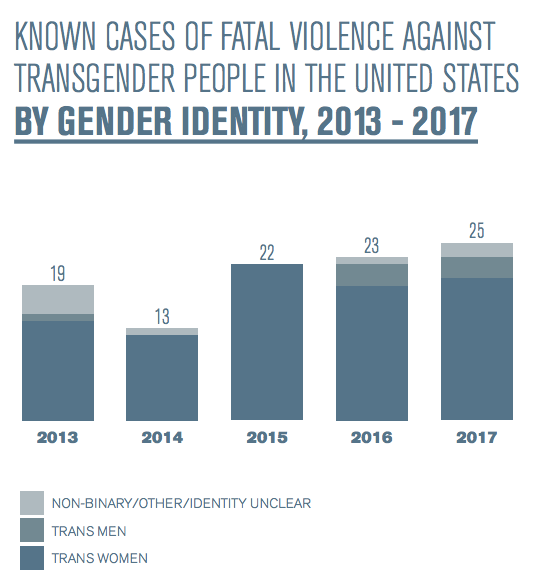Fatal violence against transgender individuals has increased in recent years, reaching a record high in 2017, according to two new reports.
At least 25 transgender people have been killed in violent crimes in the United States this year, making it the deadliest year for the trans community in recent years, according to a new report released by LGBTQ advocacy group Human Rights Campaign.

The report, released ahead of Monday’s Transgender Day of Remembrance, found that 84 percent of trans victims of fatal violence in 2017 were people of color; 80 percent were trans women, and more than 75 percent were under the age of 35.
More than half of the deaths occurred in the South, and the majority of those killed were victims of gun violence. Four of the cases HRC recorded involved altercations with police.
“The epidemic of violence against transgender people is an urgent crisis that demands the nation’s immediate attention,” Chad Griffin, HRC’s president, said in a statement.
Another report, released by the Trans Murder Monitoring research project, found that there were 325 cases of reported killings of trans and gender non-conforming people between Oct. 1, 2016 and Sept. 30, 2017. According to TMM, there were 30 more victims in that time frame than in previous dates recorded.
The majority of the deaths TMM recorded occurred in Brazil (171), Mexico (56), and the U.S. (25). Since it began recording transgender victims of violence in 2008, TMM has recorded a total of 2,609 reported cases across 71 countries.
HRC has recorded more than 100 trans victims of fatal violence since 2013, based on media and police reports. The organization estimates that their research likely undercounts the number of deaths.
“Some victims’ deaths may go unreported, while others may not be
identified as transgender in the media, often because authorities, journalists and/or family members refuse to acknowledge their gender identity,” the report states.
The 25 victims in 2017 identified in the report included three transgender women of color ― Chyna Gibson, Ciara McElveen and Jaquarrius Holland ― who were killed in Louisiana in the month of February.
The youngest victims ― Ava Le’Ray Barrin and Ally Steinfeld ― were just 17 years old.
None of the cases included in HRC’s report were classified as hate crimes, but the organization noted that transgender individuals are disproportionately affected by systemic bias and occupy a vulnerable position in the U.S.
Just 17 states and the District of Columbia have hate crime laws covering sexual orientation and gender identity, according the Movement Advancement Project, a LGBTQ research group. Roughly a third of transgender people live in poverty, and an estimated 50 percent will experience violence by an intimate partner in their lifetimes.
In the past year, discrimination against transgender people has been reflected in several policy changes and announcements from the White House. In August, President Donald Trump proposed a ban on transgender individuals entering the military ― a proposal that was shortly thereafter blocked by a district court.
Attorney General Jeff Sessions issued a memo in October reversing workplace protections for transgender employees on the basis of “religious freedom.”
“There is still so much to be done to combat transphobia across our country and around the world,” Griffin and Trans People of Color Coalition executive director Kylar W. Broadus wrote in an opening letter introducing HRC’s report.
“Nowhere is that more evident than at the doorstep of the White House, where Donald Trump and Mike Pence have made discrimination against LGBTQ people, as well as so many others, a top priority,” they added.


